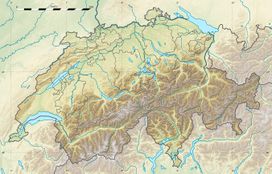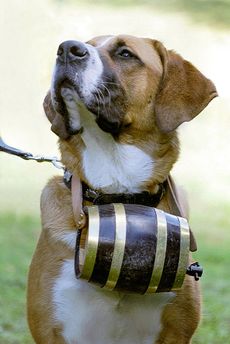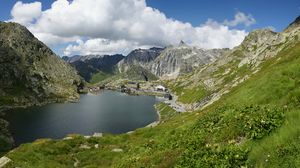ممر سان برنار الكبير
| ممر سان برنار الكبير | |
|---|---|
| Col du Grand-Saint-Bernard Great St Bernard Pass | |
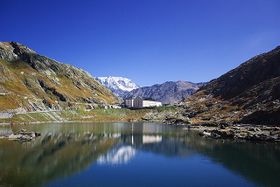 منظر الممر و hospice من بحيرة سان برنار الكبرى | |
| الارتفاع | 2٬469 م (8٬100 ق)[1] |
| يمر بأرجائه | طريق |
| الموقع | ڤاليه، سويسرا (بالقرب من الحدود الإيطالية) |
| السلسلة | الألپ الپنينية |
| الإحداثيات | 45°52′08″N 7°10′14″E / 45.86889°N 7.17056°E |
ممر سان برنار الكبير (بالفرنسية Col du Grand-Saint-Bernard؛ بالإيطالية: Colle del Gran San Bernardo؛ إنگليزية: Great St. Bernard Pass) (على ارتفاع 2469 م.) هو ثالث أعلى طريق ممر جبلي في سويسرا. ويربط مارتيني في كانتون ڤاليه في سويسرا بـأوستا في إيطاليا. وهو أوطى ممر يقع على الحافة بين أعلى قمتين في جبال الألپ، مون بلان ومونته روزا. والممر نفسه يقع في سويسرا في كانتون ڤاليه، على مقربة شديدة من إيطاليا. ويقع في الفاصل المائي الرئيسي الذي يفصل حوض الرون عن حوض الپو.[2]
سان برنار الكبير هو أقدم ممر عبر الألپ الغربية, with evidence of use as far back as the Bronze Age and surviving traces of a Roman road. In 1800, Napoleon's army used the pass to enter Italy, an event depicted in Jacques-Louis David's Napoleon at the Saint-Bernard Pass and Hippolyte Delaroche's Bonaparte Crossing the Alps, both notable oil paintings. Having been bypassed by easier and more practical routes, particularly the Great St Bernard Tunnel which opened in 1964, its value today is mainly historical and recreational.
Straddling the highest point of the road, the Great St Bernard Hospice was founded in 1049. The hospice later became famous for its use of كلاب سان برنار in rescue operations.
. . . . . . . . . . . . . . . . . . . . . . . . . . . . . . . . . . . . . . . . . . . . . . . . . . . . . . . . . . . . . . . . . . . . . . . . . . . . . . . . . . . . . . . . . . . . . . . . . . . . . . . . . . . . . . . . . . . . . . . . . . . . . . . . . . . . . . . . . . . . . . . . . . . . . . . . . . . . . . . . . . . . . . . .
الجغرافيا
المسار
The pass runs northeast-southwest through the Valais Alps (formerly known as the Pennine Alps after the Roman name for the pass, poeninus mons or summus poeninus) at a maximum elevation of 2,469 m (8,100 ft). The road running through the pass, highway E27 in both إيطاليا وسويسرا, joins Martigny on the upper Rhône river in the canton of Valais, Switzerland, to Aosta in the Aosta Valley region of Italy. From Martigny Route 9 descends to Lausanne and from Aosta Route A5 descends to Torino.
From the north (Switzerland), the route to the pass follows the Dranse River valley above Martigny, then into the wild and desolate valley of the Dranse d'Entremont. The Great St Bernard Tunnel (and the main road) plunges through the mountains at the 1,915 m (6,283 ft) level, reducing, since the tunnel's opening in 1964, the commercial relevance of the road over the pass. A reduction of utility began after the construction of the Simplon Tunnel, strictly a railway tunnel, 100 km (62 mi) to the east in 1905. The much smaller historic road winding over the pass itself, which lies a few hundred metres from the Swiss border with Italy, is only passable June to September. On the south side of the pass, the Great St Bernard Valley is drained by the Artanavaz River, which runs down to Aosta.
The pass at narrowest point runs between the peaks of Grande Chenalette at 2,889 m (9,478 ft) and Mont Mort at 2,867 m (9,406 ft). Slightly to the west in Pointe de Drône at 2,949 m (9,675 ft), the highest peak. Between it and the pass is Petite Chenalette at 2,885 m (9,465 ft).[3]
The Tour de France has visited the pass five times. It was climbed four times as a 1st category climb, and one time, in 2009, as a hors catégorie climb.[4]
الطقس
The snow in the pass in winter may be as much as 10 metres deep. The temperature may drop as low as -30°C. The lake in the pass is frozen for 265 days per year.[5] A summary of weather data for the year 1981-2010 is given below.
| Climate data for ممر سان برنار الكبير | |||||||||||||
|---|---|---|---|---|---|---|---|---|---|---|---|---|---|
| Month | Jan | Feb | Mar | Apr | May | Jun | Jul | Aug | Sep | Oct | Nov | Dec | Year |
| Mean daily maximum °C (°F) | −4.4 (24.1) |
−4.9 (23.2) |
−3.2 (26.2) |
−0.9 (30.4) |
3.7 (38.7) |
8.2 (46.8) |
11.5 (52.7) |
11.3 (52.3) |
7.5 (45.5) |
3.6 (38.5) |
−1.5 (29.3) |
−3.7 (25.3) |
2.3 (36.1) |
| Daily mean °C (°F) | −7.2 (19.0) |
−7.6 (18.3) |
−5.8 (21.6) |
−3.4 (25.9) |
1.1 (34.0) |
5.1 (41.2) |
8.1 (46.6) |
7.9 (46.2) |
4.5 (40.1) |
1.0 (33.8) |
−4.0 (24.8) |
−6.4 (20.5) |
−0.6 (30.9) |
| Mean daily minimum °C (°F) | −9.8 (14.4) |
−10.2 (13.6) |
−8.5 (16.7) |
−5.9 (21.4) |
−1.3 (29.7) |
2.2 (36.0) |
4.8 (40.6) |
5.0 (41.0) |
2.0 (35.6) |
−1.3 (29.7) |
−6.3 (20.7) |
−8.9 (16.0) |
−3.2 (26.2) |
| Average precipitation mm (inches) | 232 (9.1) |
208 (8.2) |
215 (8.5) |
232 (9.1) |
213 (8.4) |
158 (6.2) |
135 (5.3) |
136 (5.4) |
143 (5.6) |
202 (8.0) |
248 (9.8) |
246 (9.7) |
2٬368 (93.2) |
| Average precipitation days (≥ 1.0 mm) | 13.6 | 12.0 | 14.3 | 14.9 | 16.0 | 13.2 | 12.0 | 12.3 | 10.9 | 12.3 | 13.3 | 14.0 | 158.8 |
| Average relative humidity (%) | 66 | 68 | 75 | 81 | 82 | 77 | 75 | 76 | 78 | 76 | 72 | 68 | 74 |
| Mean monthly sunshine hours | 55 | 106 | 151 | 139 | 149 | 183 | 212 | 198 | 160 | 125 | 67 | 25 | 1٬571 |
| Source: MeteoSwiss[6] | |||||||||||||
البيئة
The pass is well above the tree line. All the wood required for construction and firewood must be hauled in from some distance. On the south-west side of the pass is a small tarn, the بحيرة سان برنار الكبرى، which captures melt water and does not support fish, even though attempts have been made to stock it. In past years the tarn has not always thawed completely in summer.
Alpine flowers are abundant in the vicinity: Gentiana clusii, Ranunculus glacialis, Dryas octopetala, Forget-me-not, Saxifraga oppositifolia among many hundreds more. Moss is prolific and the rocks are lichen-covered.[7]
The hospice and the dogs
A hospice for travellers was founded in 1049 by Saint Bernard of Menthon and came to be named after him in the 16th century, along with the pass. It was not the first hospice in the pass. Buildings were probably there since the Roman mansio, but the region was not secure and they were destroyed many times. The first concern of the founder of the current monastery was to clear the region of bandits and keep the pass safe for travellers, the role of rescuers developing naturally. The hospice later became famous for its use of St. Bernard dogs in rescue operations. Pope Pius XI confirmed Bernard as patron saint of the Alps in 1923.
The hospice straddles the highest point of the road, which is in Switzerland. Today the modern road for through traffic has been routed around the outside of the monastery buildings to allow some integrity of the grounds. The old road may still be seen, above the paved road. The hospice occupies two buildings, of 1560 and 1898 (picture, right). The Congregation of Canons of the Great Saint Bernard (the monks) also owns the Hôtel de l'Hospice du Grand-St-Bernard, a four-story building made of grey stone (built in 1899) on the Italian side, which it leases to a private entrepreneur for the provision of hotel services.[8]
The St. Bernards were bred large enough to traverse deep snow and to scent out lost persons. The first evidence that the dogs were in use at the monastery is two paintings dating to 1690 by Salvatore Rosa. It is often said that they carried small casks of brandy around their necks (although this is only legend), in the belief that the liquor had medicinal properties.
Today the tunnel and modern technology have made rescue operations at the pass mainly unnecessary. The dogs were put up for sale in 2004 because of the high cost of maintenance and were promptly bought by two foundations created for the purpose: Fondation Barry du Grand Saint Bernard (major contributor Christine Cerletti-Sarasin) and Fondation Bernard et Caroline de Watteville. Barry bought the kennels and the facilities in Martigny and continues to support and breed the dogs (three or four dozen). One condition of the sale is that they be brought to the monastery for the summer. Travellers are likely to see them romping around the slopes.[9] The de Watteville Foundation keeps several dogs in kennels adjunct to its Musée. Both have agreed to work together and others have joined the partnership.[10]
The monastery currently houses a handful of monks on a permanent basis and serves as a spiritual center for others on retreat.
. . . . . . . . . . . . . . . . . . . . . . . . . . . . . . . . . . . . . . . . . . . . . . . . . . . . . . . . . . . . . . . . . . . . . . . . . . . . . . . . . . . . . . . . . . . . . . . . . . . . . . . . . . . . . . . . . . . . . . . . . . . . . . . . . . . . . . . . . . . . . . . . . . . . . . . . . . . . . . . . . . . . . . . .
تاريخ
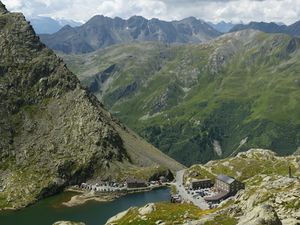
الفترة الكلتية
The pass first appears in history as the route taken by the Celtic tribes of the Boii and Lingones in the invasion of Italy of 390 BC.[11] The classical authors first mentioning the pass in that or other contexts lived the 1st century BC under the early Roman empire. They were calling the pass and the mountains Poeninus or Poenini, "Punic", an apparent reference to Hannibal's crossing. He did not cross there, however. On the presumption that the name was falsely altered by analogy, it can be reconstructed to *peninus, a Roman-Celtic word, considering that Celtic tribes owned the entire pass until defeated by the Romans.[12] Livy says that the pass was not named after the Carthaginians but after a mountain god.[13] For well over a century scholars such as the Grimm brothers have made a connection with continental Celtic pen or ben, "head, summit, chief" on an analogy with the Zeus karaios of Hesychius.[14]
Two tribes occupied the valleys on either side of the pass on a permanent basis: the Veragri on the Swiss side and the Salassi on the Italian side.
الفترة الرومانية
Julius Caesar sent an expedition under his best commander, Servius Galba, from Gaul in 57 BC to seize the pass, hoping to obtain a shorter route between Italy and Gaul than the contemporaneous coastal route. Galba was deceived by the Veragri into making camp near Martigny with the expectation of moving into the pass on the next day. At that time the Romans found the heights over the trail occupied by three hostile Gallic tribes. The Romans won a local victory by a daring foray from the camp but Galba judged he could not take the pass and departed.
Augustus succeeded where his adoptive father failed and the pass became Roman. Augustus placed a large castra stativa and colony, Augusta Praetoria Salassorum, below the pass, which became Aosta (contraction of Augusta). Its ruins are a historic attraction there. By 43 AD under the emperor Claudius a good Roman road through the pass was completed with a mansio at the top and a temple to Jupiter Poeninus, resulting in the name Mons Jovis in late antiquity, Monte Jove in the early Italian period and Mont Joux in the French period, a synonym for the pass.[5] The site of the temple is known as the Plan de Jupiter, located on a knoll on the Italian side of the pass. A cross was placed there in 1816 bearing the inscription Deo optimo maximo, "to the best and greatest god." The bronze statue of St. Bernard on a pedestal above the road on the Italian side, across a small valley from the cross, was constructed in 1905 on the site of the Roman mansio.
The coins and votive tablets found at the site of the temple roughly date the upper limit of Roman control of the pass. The youngest date to the reign of Theodosius II (1st half of the 5th century). These and other artifacts are stored in the monastery museum.[15] Fragments of the marble temple, some with inscriptions, have been incorporated into many structures of the village of Bourg-Saint-Pierre on the Swiss side of the pass. The Roman milestone for mile XXIII was also brought to the center of the settlement from the top of the pass.[16]
إمارة فرخشنيط
 مقالة مفصلة: فرخشنيط
مقالة مفصلة: فرخشنيط
العبور الناپليوني
The pass had entered history with the Gallic invasion of 390 BC. The last Gallic invasion over it occurred in May, 1800, under the direction of the 30-year-old First Consul of the French Republic, Napoleon Bonaparte. An Austrian army of 140,000 men had laid siege to French-occupied Genoa on the west coast of northern Italy. Napoleon traversed the pass with 40,000 men and 1/3 of their heavy artillery sending another 20,000 over three other passes as a diversion, intending to strike the Austrian rear. The panicked Austrians were unable to assemble fast enough to meet the French en masse but rather in a piecemeal way in June 1800, and so were defeated first at the Battle of Montebello and then at the Battle of Marengo.
Napoleon prepared for the march secretly by assembling men in small units below the pass, establishing supply dumps along the lower part of their route, and hiring artisans to set up shop along it as well. On May 15 an advance unit went over the pass to take Aosta, after which hospitals were set up at Martigny and Aosta. At Martigny the army assembled and received rations for three days. All the equipment - carriages, artillery, arms and ammunition - was disassembled and divided into packs of 60-70 pounds for the men to carry. The cannons were to be dragged up over the snow in hollowed-out pine half-logs by mules, and then when the mules died or were exhausted, by 100 soldiers and hired men each. Napoleon offered liberal monetary rewards to soldiers and laborers who could perform difficult portages in a timely fashion.

Over several days at the end of May the army went over the pass single-file, 6000 men per day. Bands played martial music along the route, with drum rolls at especially difficult places to alert the men. At the top the monks handed each man two glasses of wine and a slice of rye with cheese as he filed by (courtesy of the French army). Accounts of the amounts expended vary. On the other side the snow became so packed that the men slid down sitting. Napoleon was the last man over, sliding also. The good weather held for the entire crossing, which could easily have turned into a disaster, if it had not.
On the way up Napoleon had discussed affairs of the heart with his young guide and mule driver, Pierre Nicholas Dorsaz, who did not know his identity. Offered a reward at the top, Dorsaz asked for the mule on which Napoleon was riding. He received the mule and a short note for the chief supply officer of the army. Versions of the story vary, but they all agree that when the young man had turned in the note and had drawn his ample pay for the work, he found that his companion was Napoleon and the latter had given him a house and farm so that he could marry his sweetheart.
In the Aosta Valley Napoleon's army slipped by an Austrian garrison at Bard just out of cannon range. The commander related that he was astonished to watch an army of 40,000 men in full equipment go marching past from the direction of the heights.[17][18]
الهامش
- ^ خرائط سويستوپو
- ^ The border between the two countries runs along a straight line from the Petite Chenalette to the Mont Mort, instead of following the watershed
- ^ Haub, Gangolf (2004–2006). "Grande Chenalette". summitpost.org. Retrieved 3 May 2009.
- ^ "Le col du Grand-Saint-Bernard dans le Tour de France". Retrieved 6 August 2013.
- ^ أ ب Walker, Joan Hustace (1998). Saint Bernards: everything about purchase, care, nutrition, breeding, behavior, and training (illustrated ed.). Hauppauge, NY: Barron's Educational Series. p. 5. ISBN 9780764102882.
- ^ "Climate Normals Col du Grand St−Bernard 1981-2010" (PDF). Climate diagrams and normals from Swiss measuring stations. Federal Office of Meteorology and Climatology (MeteoSwiss). Retrieved January 21, 2013.
- ^ King (1858), p.9.
- ^ Porter, Darwin; Danforth Prince (2008). Frommer's Switzerland (13, illustrated ed.). Frommer's. p. 246. ISBN 0-470-18188-5. ISBN 9780470181881.
- ^ "Communiqué". Fondation Barry du Grand Saint Bernard. 2005. Retrieved 11 May 2009.
- ^ "Musée et Chiens de Saint-Bernard". Retrieved 11 May 2009.
- ^ History of Rome, V.35.
- ^ Falileyev, Alexander, ed. (2007). "Summus P(o)eninus" (pdf). Dictionary of Continental Celtic Place-Names. Aberystwyth University. Retrieved 2 May 2009.
- ^ History of Rome XXXI.38.
- ^ Grim, Jacob Ludwig Carl (2003). Teutonic Mythology Part 1. Kessinger Publishing. p. 169. ISBN 0-7661-7742-4. ISBN 9780766177420.
- ^ King (1858), p. 11.
- ^ Cochell, Christie (2003). "Crossroads of the Alps". The World and I. Retrieved 12 May 2009.
- ^ Morgan, James (1915). In the Footsteps of Napoleon: His Life and Its Famous Scenes. Kessinger Publishing, LLC. pp. 120–126.
- ^ Abbott, John C. (June–November 1852). "Napoleon Bonaparte". Harper's. 5: 11–18.
ببليوگرافيا
- King, Samuel William (1858). The Italian Valleys of the Pennine Alps: A Tour Through All the Romantic and Less-frequented "vals" of Northern Piedmont, from the Tarentaise to the Gries. London: J. Murray.
. . . . . . . . . . . . . . . . . . . . . . . . . . . . . . . . . . . . . . . . . . . . . . . . . . . . . . . . . . . . . . . . . . . . . . . . . . . . . . . . . . . . . . . . . . . . . . . . . . . . . . . . . . . . . . . . . . . . . . . . . . . . . . . . . . . . . . . . . . . . . . . . . . . . . . . . . . . . . . . . . . . . . . . .
انظر أيضاً
- List of highest paved roads in Europe
- List of mountain passes
- List of the highest Swiss passes
- Little St Bernard Pass
- San Bernardino Pass
- Great St Bernard Tunnel
وصلات خارجية
- Fisher, Ian (October 29, 2004). "Great St. Bernard Pass Journal; This Time, It's the Faithful Hero That Needs the Rescue". New York Times.
- "Cycling Profiles - Both sides". Cycling Challenge. Retrieved 9 July 2008.
- Fletcher, Adrian (2000–2009). "Colle del Gran San Bernardo 2473m". Paradoxplace. Retrieved 14 April 2009.
- "Le col du Grand Saint Bernard" (in French). www.swisscastles.ch. 1997. Retrieved 14 April 2009.
{{cite web}}: CS1 maint: unrecognized language (link) - "The Saint Bernard Pass". Naturhistorisches Museum der Burgergemeinde Bern. Retrieved 11 May 2009.
- Le col du Grand Saint-Bernard dans le Tour de France (بالفرنسية)
- Col du Grand-Saint-Bernard on Google Maps (Tour de France classic climbs)
- Pages using gadget WikiMiniAtlas
- Coordinates on Wikidata
- Pages using infobox mountain pass with unknown parameters
- Articles containing إنگليزية-language text
- Pages using Lang-xx templates
- Articles with hatnote templates targeting a nonexistent page
- معابر حدود إيطاليا-سويسرا
- Mountain passes of Switzerland
- Mountain passes of the Alps
- Mountain passes of Valais
- Climbs in cycle racing
